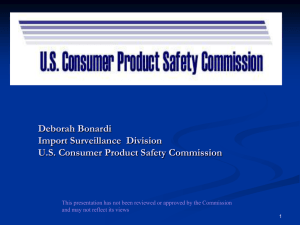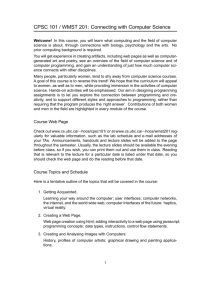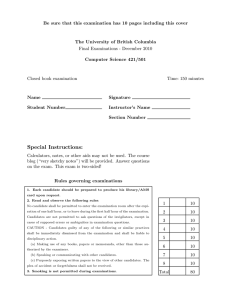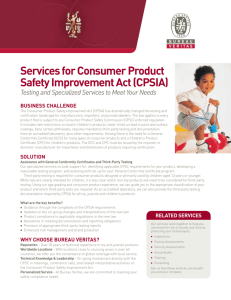Consumer Product Safety Improvement Act: How Does it
advertisement
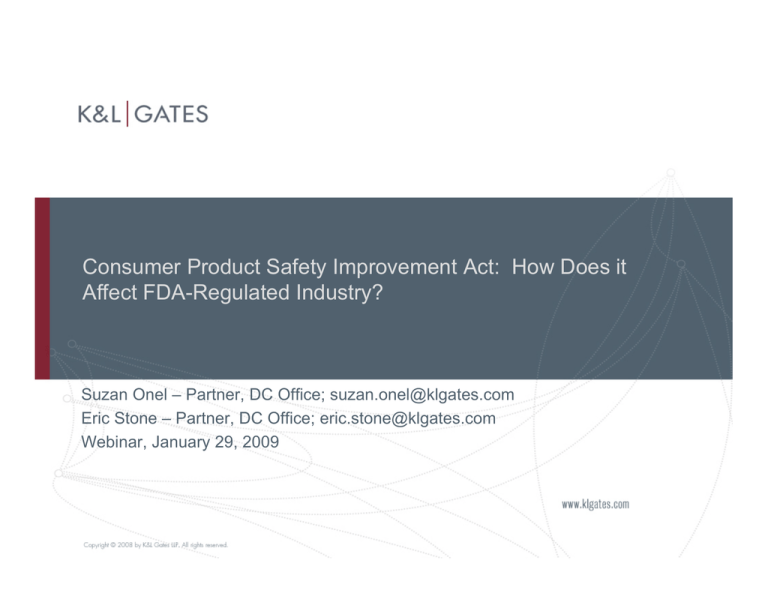
Consumer Product Safety Improvement Act: How Does it Affect FDA-Regulated Industry? Suzan Onel – Partner, DC Office; suzan.onel@klgates.com Eric Stone – Partner, DC Office; eric.stone@klgates.com Webinar, January 29, 2009 Consumer Product Safety Commission A little context: Under the Consumer Product Safety Act (CPSA), the Consumer Product Safety Commission (CPSC) has jurisdiction over approximately 15,000 “consumer products.” Used in or around a permanent or temporary household or residence, school, in recreation, or otherwise. For personal use, consumption or enjoyment. Also jurisdiction over hazardous substances, packaging, and fabrics under other Acts. 1 Food and Drug Administration A little context: Under the Federal Food, Drug, and Cosmetic Act, the Food and Drug Administration (FDA) has jurisdiction over 25 cents of every consumer dollar spent. Food, dietary supplement, prescription drugs, overthe-counter (OTC) drugs, cosmetics, biologics, medical devices, and veterinary products. 2 CPSC Jurisdiction Does Not Include: Foods, drugs, cosmetics or medical devices but … 3 Jurisdictions Intersect and Overlap: Federal Hazardous Substance Act (FHSA) does not expressly exclude medical devices and can reach containers and packaging of cosmetics and food. Poison Prevention Packaging Act (PPPA) expressly grants agency authority over packaging for controlled drugs and certain Rx drugs, OTC drugs, dietary supplements, and cosmetics. 4 Historical View of Agency Intersect Food Containers: Mechanical or outside of container issueÆCPSC; leaching into foodÆFDA. Child Resistant PackagingÆCPSC; stability, safety or effectivenessÆFDA. CosmeticsÆFDA, except when part of a toy, then CPSC. Medical devicesÆFDA, but line is blurry for some OTC devices. 5 CPSC Authority To set safety standards; Ban products; Recall products that present a “substantial product hazard”; Investigate using inspections or subpoenas; and Enforce by refusing entry to imports, seizing violative products, civil, and criminal penalties. 6 2007-2008 Major Incidents Prompting Complete Review of CPSC Authority and Product Safety Violations of lead paint ban in toys and children’s products. Magnets and other defects in toys. Crib recalls. Melamine in pet food, toothpaste, infant formula. Hazardous chemicals in toys, e.g., Aquadots with chemical that metabolized into GHB. Increasing public concern about phthalates and bisphenol A (BPA) in food packaging and children’s toys. 7 Reactions Commission set up import team to work with U.S. Customs and Border Protection (CBP) and find violative product at ports. Increased enforcement actions and recalls. Actions by State governments. Congress passed Consumer Product Safety Improvement Act of 2008 (CPSIA). 8 Consumer Product Safety Improvement Act of 2008 Public Law 110-314; Enacted August 14th, 2008 Effective date: November 12, 2008 9 CPSIA-- Highlights Reauthorizes CPSC. Significantly expands CPSC’s authority. Provides steady increase in resources. Creates new obligations for manufacturers of consumer products. General Certificate of Conformity Third Party Testing for Certain Children’s Products Phthalate Standard Total Lead Limits 10 General Certificate of Conformity Certification requirement applies to all manufacturers of domestic products, or importers of products, subject to any consumer product safety rule, ban, standard, or regulation enforced by the CPSC. Broad applicability across “consumer products.” If product has a pediatric indication, may be subject to additional third party testing requirements. CPSIA Section 102. 11 General Certificate of Conformity Certificate must be based on a test of the individual product or a “reasonable testing program.” Certificate must “accompany” the product or shipment of products covered by the certificate. A copy of the certificate must be “furnished” to each distributor or retailer of the product. 12 Implementation of Certification Requirement Initially, CPSC to focus enforcement efforts on product compliance with safety requirements. Only domestic manufacturers and importers need to issue certificates for now. Electronic certificates can “accompany” products and can be “furnished” to distributors or retailers through posting on a website or other electronic means. CPSC Final Rule: 73 Fed. Reg. 68328, 68331 (Nov. 18, 2008) 13 Content of Certificate (Section 102(g)) Name of product(s) covered by the certificate and citation to each applicable CPSC regulation, rule, standard, or ban; Date and place of manufacture; Date and place where the product was tested; Identification of manufacturer or importer certifying compliance (including full mailing address and telephone number); Contact information of party maintaining records of test results; and Identification of any third party laboratory, if applicable. 14 Ambiguities Applicable products - does not include those products voluntarily complying. Method of certification - paper or electronic certificate? Single posting? Lot by lot? Product by product? How should information be displayed on websites? “Date and place product was manufactured.” “Date and place product was tested.” “Reasonable testing program.” Who should supply certificate when multiple parties make components of the same product? 15 Third Party Testing Requires manufacturers of “children’s products” to have products tested by accredited third parties to establish conformity with CPSC regulations. For children 12 and under; CPSC setting standards for approval of such conformity assessment firms; Maintain test records minimum of 3 years; CPSIA Section 102. 16 Third Party Testing Effective dates: Dates depend on each regulation. Upcoming effective dates include: Lead paint by December 21, 2008; Cribs and pacifiers by January 2009; Small parts by February 2009; Metal jewelry by March 2009; Baby bouncers, walkers, and jumpers by June 2009; 300 ppm lead content limit by August 2009; and Children’s Product Safety Rules by September 2009. 17 Other Requirements for “Children’s Products” New standards and regulation for children’s nursery products (CPSIA Section 104). Labeling and advertising requirements (CPSIA Section 105). Websites (Dec. 2008) Catalogs (Feb 2009, but Commission will give firms whose catalogs were published before Feb. 2009 until August 2009) 18 Phthalate Standard Essentially bans children’s toys or “child care articles” that contain certain phthalates (CPSIA Section 108) including: BBP, DEHP, and DBP; Interim ban of such items that may be mouthed including DIDP, DINP, or DNOP; Effective: February 10, 2009. 19 Phthalate Standard “Children’s toy” defined as “consumer product designed or intended … for a child 12 years of age or younger for use by the child when the child plays.” “Child care article” defined as “consumer product designed or intended … to facilitate sleep or the feeding of children age 3 and younger or to help such children with sucking or teething.” 20 Ambiguities Retroactive application to existing inventory. CPSC has said “No” (Advisory Opinion 11/17/08) Application to houseware products (plates, cups, baby bottles, feeding utensils). CPSC has said “Yes” to pacifiers CPSC has said “No” to toothbrushes Medical devices fall outside “consumer products” definition, but some appear to fall within intended meaning and wording of statutory provision Need to test non-plastic products to certify? 21 Total Lead Limits Ban of children’s products containing more than 600 ppm of lead (CPSIA Section 101). Effective date: February 2009 Banning level to be reduced in August 2009 to 300 ppm 100 ppm in 2011 if technologically feasible. Surface coatings. Inaccessible component parts exempted. 22 Lead limits Mandatory third party testing for lead paint and (in March) children’s jewelry. Retroactive application to inventory. CPSC has said “Yes” (Advisory Opinion 9/12/08) 23 Ambiguities Definition of “inaccessible component part.” Testing methods and third party accreditation. Preemption of state requirements. 24 Other Notable Provisions ASTM F963-07 voluntary standard for toys adopted as mandatory standard effective Feb. 10, 2009. Broader reporting and recall authority to include all products regulated by CPSC under all of its statutes. Substantial hazard rules based on voluntary standards. State Attorney General Enforcement. Civil penalties to increase to $15 million by August 2009. Felony authority for criminal violations. 25 Ambiguities New reporting and recall authority appears to apply over products whether or not they are “consumer products.” May expand reporting and recall obligations of FDA-regulated products if related to a PPPA or FHSA violation. ASTM F963-07 toy standard incorporates by reference FDA requirements for cosmetics, food, and cooking containers, but states that cosmetics for children under 8 must still meet the toy standard. Uncertain applicability to other products. Since standard is not expressly limited to “consumer products,” teething toys and other products are potentially subject to its requirements. 26 Thank you Questions?? Suzan Onel: 202-778-9134 suzan.onel@klgates.com Eric Stone: 202-778-9014 eric.stone@klgates.com 27 Below are links to the CPSC sample certificate and instructions and several company certificates that are publicly available over the Internet. We do not endorse any specific company certificates, but provide them merely as examples of potential ways to structure the General Certificate of Conformity. For examples, please see: http://www.cpsc.gov/ABOUT/Cpsia/faq/elecertfaq.pdf http://www.forbarefeet.com/CPSIA/CPSIAchildrenssocks.pdf http://www.chamberlain-diy.com/NR/rdonlyres/052288BC-7BE542F4-BE6301907782467B/2128/CPSIAcertificate_CGIjan2009.pdf http://www.turtlewax.com/res/CPSIA_Certificate.pdf http://www.schering-plough.com/binaries/CPSIA.pdf 0 Suzan Onel AREAS OF PRACTICE WASHINGTON OFFICE 202.778.9134 TEL 202.778.9100 FAX suzan.onel@klgates.com Ms. Onel practices FDA law with a primary focus on regulatory issues involving medical devices, foods, dietary supplements, over-the-counter drugs, cosmetics and consumer products. She regularly advises international and domestic manufacturers, distributors, and researchers on market entry strategies, labeling and promotional activities, regulatory compliance, recalls and field corrections, and enforcement defense. Ms. Onel assists clients with the preparation of FDA submissions, including 510(k) premarket notifications, premarket approval applications (PMAs), food additive petitions, GRAS self-affirmations and notifications, food contact notifications, new dietary ingredient notifications, and adverse event reports. Ms. Onel’s experience includes representing clients before the U.S. Food and Drug Administration; the Federal Trade Commission; the U.S. Department of Agriculture; the Bureau of Alcohol, Tobacco, and Firearms; the National Advertising Division of the Better Business Bureaus; and similar international and state bodies. Ms. Onel’s practice also includes advising on transactional matters such as due diligence investigations related to life science company acquisition, divestment and capital growth as well as supplier contracts and clinical research agreements. Additionally, she counsels clients on trademark and copyright protection, unfair competition, the Lanham Act, trade dress, and Internet-related issues. PROFESSIONAL BACKGROUND Ms. Onel regularly speaks and writes on FDA issues including medical device software, food regulation, and dietary supplement/functional food. She has written articles and chapters in compilations published by the Food Drug Law Institute, the Regulatory Affairs Professionals Society, Medical Device & Diagnostic Industry, and others. PUBLICATIONS “Building and Retaining Trust in the Biomedical Community,” Cleveland Clinic Journal of Medicine, written for Dick Thornburgh. March 2007. Chapter,” Postmarket Requirements for Significant Risk Devices,” Clinical Evaluation of Medical Devices, Principles and Case Studies, (2nd. Ed.). “Dietary Supplements: A Definition that is Black, White and Gray,” American Journal of Law and Medicine, vol. 31, 2005. “FDA Regulation of Medical Device Software: A Delicate Balancing Act,” Journal of BioLaw and Business, Volume 6, Number 4, 2003. “Sponsor Responsibilities and Liabilities for Clinical Investigator Fraud,” American Lawyers Media, Pharmaceutical & Medical Device Law Bulletin, October 2002. “FDA Finalizes Rule that Could Expand OTC Drug Marketplace,” Food Drug Law Institute (FDLI) Update, September/October 2002. “Functional Foods, Nutraceuticals, Designer Foods: What Are They and How Are They Regulated?” Regulatory Affairs Professionals Society (RAPS) Focus Magazine, April 2001. Suzan Onel “Copyright and Trademark Compliance on the Web: Are Device Makers Vulnerable?” Medical Device and Diagnostic Industry Magazine, June 2000. “Dietary Supplement Makers, Sellers Must Guard Against Liability Suits,” Leader Publication: Product Liability Law and Strategy, April 2000. “FDA Regulation of Dietary Supplements: A Work in Progress,” RAPS Focus Magazine, May 1999. “Copyright and Trademark Compliance on the Web: Is your Association Vulnerable?” Association Law and Policy Newsletter, April 1999. “Medical Device: Y2K Problem,” International Commercial Litigation, June 1998. “Draft Revision of FDA’s Medical Device Software Policy Raises Warning Flags,” MDDI Magazine, Oct. 1997. “Cosmetic Regulation Revisited,” Chapter 11, Food Drug Law Institute (FDLI), Fundamentals of Law and Regulation, 1997. “Pharmaceuticals and Cosmetics,” Kirk-Othmer Encyclopedia of Chemical Technology, 4th Ed., 1997. “Recent Enforcement Activity Under the PDMA,” Pharmaceutical Distribution Marketing Audit Update, 1994. “FDA’s Administrative Procedures,” FDLI Compilation, 1993. “Legal Trends in Bioethics,” Journal of Clinical Ethics (quarterly column), 19911992. “The Medical Waste Tracking Act of 1988: Will it Protect Our Beaches?” Virginia Environmental Law Journal, 1989. PRESENTATIONS “Views from the Center: Implementing the FDA AA in an Age of Rapid Scientific Advancement,” Food and Drug Law Institute (FDLI) Annual Conference, Washington, DC, March 2008. “Public Policy and Neurotech,” Third Annual Neurotech Industry Investing and Partnering Conference (NeuroInsights), Boston, MA, May 2008. “Medical Device Regulator Compliance,” 3-day conference for CFPA, New Brunswick, NJ, November 2007. “Special Concerns for Manufacturing and Marketing Functional Foods,” ACI, San Francisco, CA, May 2007. “Medical Device Regulatory Compliance,” 3-day conference for CFPA, New Brunswick, NJ, October 2006. “Introduction to Medical Device Law & Regulation,” FDLI, Washington, DC, January 2006. “Medical Device Regulatory Compliance,” 3-day conference for CFPA, Millbrae, CA, September 2005. “Introduction to Medical Device Law & Regulation,” FDLI, Washington, DC, May 2005. “Medical Device Regulatory Compliance,” 3-day conference for CFPA, Northbrook, IL, October 2004. “Patent Protection for Medical Devices, Law and Strategy,” Minnesota State Bar Association, May 17, 2004. Suzan Onel “Food Allergens: Thresholds, Labeling, Manufacturing, and Consumer Issues,” 47th Annual Conference of FDLI, Washington, DC, April 16, 2004. “Medical Device Regulatory Compliance,” 2-day conference at Steris Corporation, October 2, 2003. “FDA Regulation of Electronic Records under Part 11,” Biotechnology Industry Organization (BIO) Annual Convention, Washington, DC, June 2003. The Role and Impact of Government Entities on Herbal Supplement Regulation and Litigation,” Mealeys’ Ephedra Litigation Conference, Pasadena, CA, April 2003. “US Regulatory and Market Considerations for the Medical Device Industry,” videoconference simulcast to Austrade Australian Chamber of Commerce in Sydney and Melbourne, Washington, DC, March, 2003. “Medical Device Regulatory Compliance,” 3-day conference for CFPA, New Brunswick, NJ, March 2003. “Introduction to Medical Device Law and Regulation,” FDLI, Washington, DC, October 2002. “Overview of Dietary Supplement Labeling and Advertising Claims,” RAPS Annual Conference, Baltimore, MD, November 2001. “FDA Regulation of Computer Software,” Biopharmaceutical Division of the Institute for International Research (IIR), Philadelphia, PA, March 2001. “The Internet: Intellectual Property Points to Consider,” National Center for Non-Profit Law, DC, November 2000; October 1999. “Dietary Supplement Claims: Current Issues,” Regulatory Affairs Professionals Society (RAPS) Annual Conference, DC, October 1999. “The Regulation of Dietary Supplements,” 2-Day RAPS Conference, DC, August 1999. “Medical Device Regulation,” CFPA, New Brunswick, NJ, March 1999; March 1998. “Trademark and Copyright Compliance on the Internet,” Arts and Culture on the Net: Legal Issues of Fundraising and Marketing (multiple sponsors including American Association of Museums, Washington Area Lawyers for the Arts, and the Smithsonian), DC, November 1997. “Sunscreens: Evaluating Ingredients, Regulatory Landscape, and New Products on the Horizon,” Global Business Research, Ltd., Philadelphia, PA, July 1997. “Interacting with the FDA,” CFPA, New Brunswick, NJ, March 1995. PROFESSIONAL/CIVIC ACTIVITIES ABA ABA’s Technology Assessment Committee, former Co-Chair ALM’s Pharmaceutical & Medical Device Law Bulletin, Editorial Board District of Columbia Bar Association Food and Drug Law Institute Food Drug Law Institute Update Editorial Advisory Board Regulatory Affairs Professional Society Suzan Onel BAR MEMBERSHIP District of Columbia Pennsylvania EDUCATION J.D., University of Virginia, 1990 (Notes Editor, Virginia Environmental Law Journal) B.A. (Neurobiology and European Intellectual History), University of Pennsylvania, 1986 (Honors) Eric L. Stone AREAS OF PRACTICE Eric Stone is a partner in the firm’s Washington, D.C. office. PROFESSIONAL BACKGROUND WASHINGTON, D.C. OFFICE 202.778.9000 TEL 202.778.9100 FAX eric.stone@klgates.com Prior to joining K&L Gates, Mr. Stone was the director of the Legal Division of the Office of Compliance and Field Operations at the Consumer Product Safety Commission and acting director of the Recalls and Compliance Division. While at the CPSC, Mr. Stone supervised product recall cases, investigations of possible substantial product hazards, and violations of Commission regulations. He also was responsible for developing civil penalty cases against firms that failed to report potential hazards or violated Commission safety standards and bans, and for initiating criminal prosecutions. BAR MEMBERSHIPS District of Columbia (Inactive) Maryland EDUCATION J.D., American University Washington College of Law, 1976 B.A., Franklin & Marshall College, 1974
